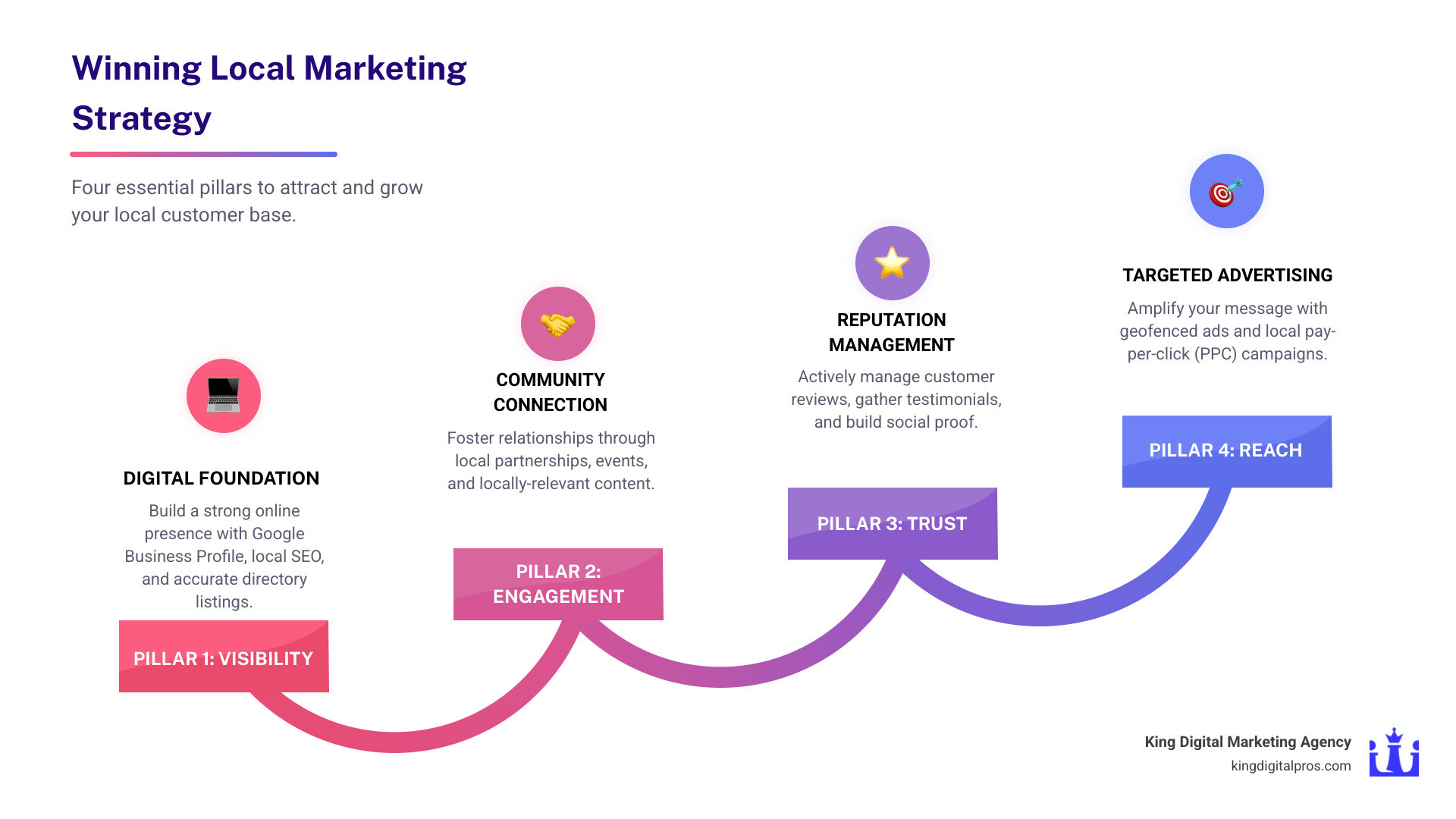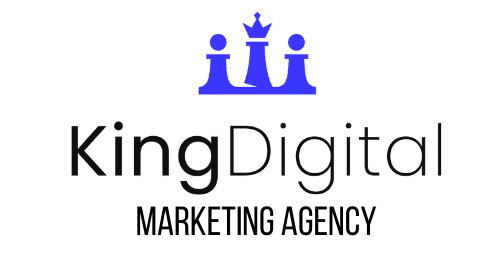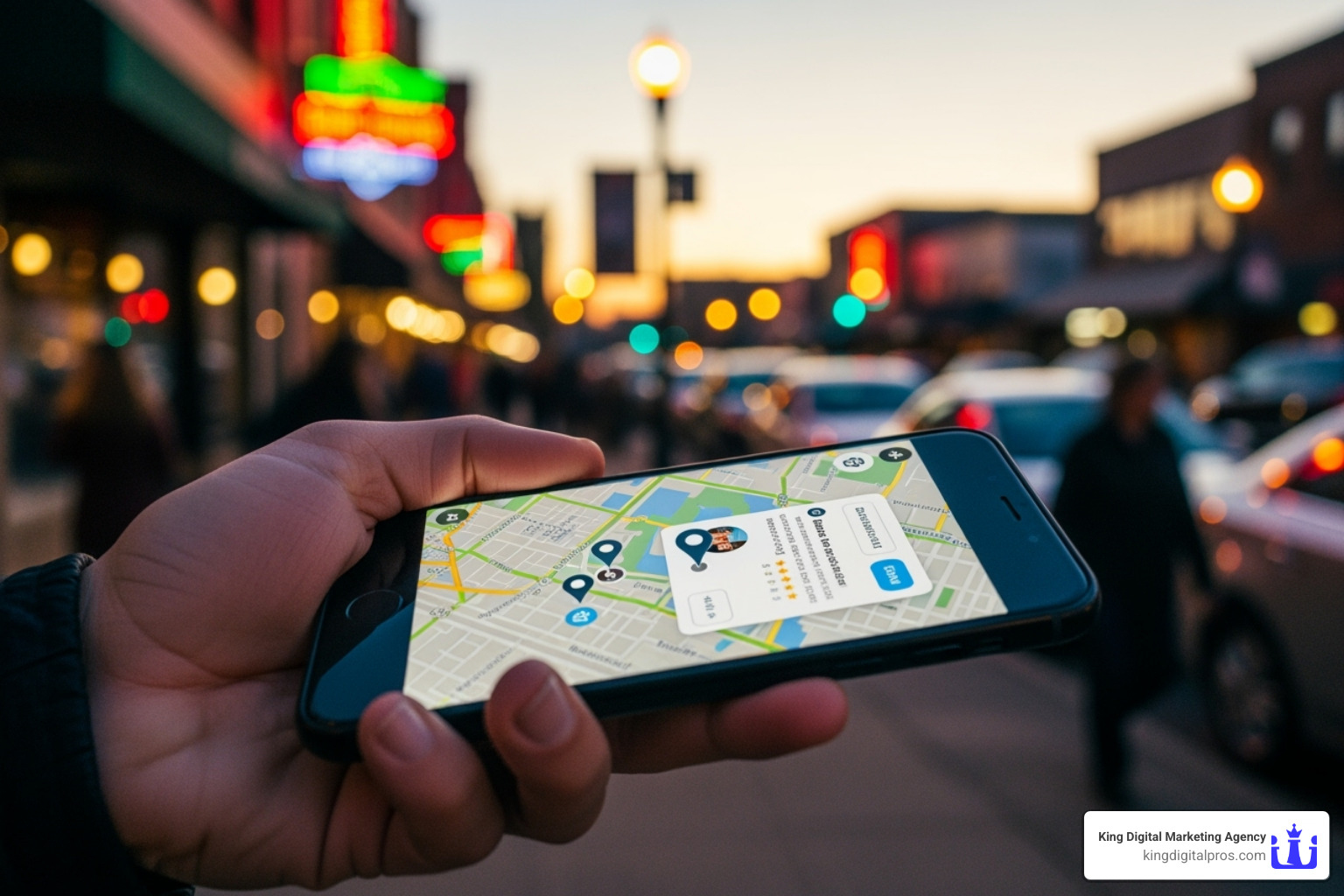Why Local Marketing Strategy is Your Key to Business Growth
A local marketing strategy is a targeted approach to promoting your business within a specific geographic area. It uses both digital and traditional methods to attract nearby customers. The core components include:
- Online Presence: Google Business Profile, local SEO, and directory listings.
- Community Engagement: Local partnerships, events, and sponsorships.
- Reputation Management: Customer reviews and testimonials.
- Targeted Advertising: Geofenced ads and location-based campaigns.
Local businesses face a simple reality: the vast majority of customers find local businesses online before visiting in person. Yet many owners struggle with poor search visibility and competition from larger chains.
The shift from traditional phone books to digital search has changed how customers find services. When someone searches “plumber near me,” they want a business that understands their community.
Unlike broad national campaigns, local marketing lets you build genuine relationships. You can sponsor a local sports team, partner with a neighboring business, or create content about community events. This hyperlocal approach gives small businesses a massive advantage, allowing you to become a trusted neighborhood expert.
I’m Bernadette King, and I’ve spent years helping small businesses transform their digital presence through targeted local marketing strategy implementation. My experience shows that the most effective local marketing combines strategic online optimization with genuine community engagement.

Building Your Digital Foundation for Local Visibility
Your digital foundation is the cornerstone of your local marketing strategy. Without a strong online presence, even the most creative campaigns will struggle to reach local customers. The good news is you don’t need to be a tech wizard to get this right.
Optimize for Local Search Engines (SEO)
Local SEO is your secret weapon for getting found by customers at the exact moment they need you. It’s the difference between being invisible online and showing up at the top of local search results.

- Local Keyword Research: Your customers use location-specific terms like “best pizza delivery near me.” Understanding these phrases helps you speak their language.
- On-Page SEO: Weave local keywords and references to your neighborhood naturally into your website content. Search engines and customers appreciate this local flavor.
- Service Area Pages: If you serve multiple locations, create dedicated pages for each one. This helps you dominate local searches in each specific area you serve.
- Structured Data: This behind-the-scenes code acts like a detailed business card for search engines, helping them understand your location and services. Google provides comprehensive guidelines on structured data for local businesses to help with implementation.
Master Your Google Business Profile (GBP)
Your Google Business Profile is your free digital storefront and often a customer’s first impression. Claiming and fully optimizing it is a top priority.
- Complete Every Section: Ensure your business name, address, phone number (NAP), hours, and description are accurate and detailed.
- Post Regularly: Share photos, announce special offers, and post updates to show Google and customers that you’re an active business.
- Use the Q&A Section: Answer common customer questions to address concerns proactively.
- Upload High-Quality Photos: Showcase your work, space, and team. Profiles with great photos get more clicks and calls.
Leverage Local Directories and Citations
Beyond Google, your local marketing strategy needs a presence across the web. Think of online directories as digital phone books that build your credibility.
Key platforms include Yelp and Bing Places, but industry-specific directories (like OpenTable for restaurants or Angi for contractors) are also valuable. The golden rule is NAP consistency: your Name, Address, and Phone number must be identical everywhere. Even minor differences can confuse search engines and hurt your rankings. Focus on general directories, map services, social platforms, and industry-specific sites to build a solid foundation.
Crafting Your Core Local Marketing Strategy
With your digital foundation in place, it’s time to transform your business from an online listing into a beloved community fixture. This phase is about building relationships that create long-term loyalty.
Develop a Content Plan That Resonates Locally
Local content is powerful because it speaks directly to your neighbors’ lives. It positions you as a helpful expert, not just a business.
- Create Local Guides: A hardware store could publish “A Local’s Guide to Winterizing Your Home.” This provides genuine value and establishes expertise.
- Highlight Community News: Celebrate local achievements, like a high school championship win, to show you’re an engaged member of the community.
- Showcase Customer Stories: Feature real experiences from local customers to build authentic trust and emotional connection.
- Answer Local FAQs: Address challenges specific to your area, such as a landscaping company writing about “Plants That Thrive in Our Climate.”
Connect with Your Community on Social Media
For local businesses, social media is about building connections with people who can walk through your door. Focus on the platforms where your customers spend their time.
- Use Geo-Targeting: Target posts to users within a specific distance of your business to ensure your content reaches a relevant audience.
- Leverage Local Hashtags: Use tags like #YourCityEats or #NeighborhoodLife to help locals find your business.
- Run Contests: A simple giveaway can build buzz and spread brand awareness quickly and cost-effectively.
- Encourage User-Generated Content: When customers post about their great experience, it serves as powerful social proof. Reshare their content to show appreciation.
Forge Powerful Local Partnerships
When local businesses work together, everyone wins. Collaborating with complementary businesses creates opportunities to reach new customers.
- Sponsor Local Events: Sponsoring a street fair or a little league team shows you’re invested in the community’s success.
- Support Local Charities: Align your business with causes your customers care about to build loyalty that goes beyond transactions.
- Cross-Promote: Simple actions like sharing business cards with a neighboring shop can introduce you to a new stream of customers.
Authentic community involvement is key to building a good reputation. As noted by the U.S. Chamber of Commerce, being an active part of your community directly impacts how customers perceive and choose local businesses (https://www.uschamber.com/co/grow/marketing/community-involvement-benefits-business).
Amplifying Your Reach with Local Ads
While organic strategies build lasting connections, local advertising provides the extra push needed to cut through the noise. Today’s digital ad platforms offer incredible precision, allowing you to reach the right people at the right moment.
Target Precisely with Local PPC Campaigns
Google Ads is a powerful tool in a local marketing strategy. When someone in your area searches for your services, your ad can appear at the very top of the results.
- Location Targeting: Show your ads only to people in specific cities, zip codes, or within a precise radius of your business. This ensures every click has the potential to become a customer.
- Call-Only Ads: For businesses that rely on phone calls, these ads are invaluable. They allow customers to call you with a single tap, skipping the website entirely. This is perfect for emergency services or contractors.
- Local Landing Pages: When someone clicks your “Albuquerque plumbing repair” ad, they should land on a page specifically about that service in that city. This seamless experience dramatically improves conversion rates.
By tracking conversions, you can ensure every ad dollar is working for your business, allowing you to focus your budget on what drives real results.
Use Social Media Ads to Engage a Local Audience
Social media advertising helps you build relationships and create awareness. While Google Ads capture active searchers, social ads can generate new demand.
- Facebook Local Awareness Ads: These are designed to drive foot traffic by targeting people currently in or frequently visiting your area.
- Instagram Location Tags: Connect your ads to specific places, increasing the chance they’ll be seen by people searching for content related to your neighborhood.
- Retargeting: Remind website visitors who didn’t convert about your business with a well-timed ad. A special offer can be the nudge they need to become a customer.
Understanding your ad objectives is key to choosing the right campaign for your goals.
| Ad Objective | Primary Goal | Best For |
|---|---|---|
| Brand Awareness | Increase recognition of your business | New businesses, reaching a broad local audience |
| Website Clicks | Drive traffic to your website or landing page | Promoting online orders, specific product pages, or service descriptions |
| Store Traffic | Encourage in-store visits | Retailers, restaurants, any business relying on foot traffic |
Successful local advertising combines precise targeting with compelling messages to turn your ads into powerful customer magnets.
Building Trust and Credibility with Online Reviews
Online reviews are your digital reputation. Before making a decision, potential customers are reading what others have said about you. In fact, research shows that the vast majority of consumers read online reviews before making a purchase, making review management an essential part of your local marketing strategy.
How to Encourage and Manage Customer Reviews
Getting great reviews is about having a system that makes it easy for happy customers to share their experiences.

- Ask at the Right Time: When a customer expresses satisfaction, that’s the perfect moment to ask for a review.
- Make It Simple: Send customers a direct link to your Google Business Profile review page via email or text. This removes friction and increases the likelihood they’ll follow through.
- Respond to All Feedback: Thank customers for positive reviews, mentioning a specific detail from their experience. For negative reviews, respond quickly and professionally. Acknowledge their concerns and offer to make things right. How you handle criticism can build more trust than a perfect record.
We help businesses develop comprehensive reputation management strategies that turn customer feedback into a powerful marketing asset.
Showcase Your Best Reviews
Don’t let your best reviews hide on third-party platforms. Put them to work across your marketing channels.
- Add Testimonials to Your Website: Turn your service pages into authentic stories by featuring detailed reviews from satisfied customers.
- Create Social Media Posts: Turn a heartfelt review into an attractive graphic for Facebook or Instagram. This user-generated content feels genuine and often gets high engagement.
- Use Reviews in Advertising: Instead of saying “We’re the best,” let your customers say it for you. Featuring star ratings or quotes in your ads provides instant credibility.
According to BrightLocal’s annual Local Consumer Review Survey (https://www.brightlocal.com/research/local-consumer-review-survey/), consumers overwhelmingly rely on reviews to make purchasing decisions. This social proof is critical for building the trust that turns a potential customer into a loyal one. We work with businesses to build and maintain their online reputation by strategically showcasing these valuable customer insights.
Measuring Success and Adapting Your Strategy
A local marketing strategy requires ongoing attention. The most successful businesses continuously track their performance, learn from the data, and make smart adjustments. Without measurement, you’re flying blind, potentially wasting money on ineffective tactics.
Key Metrics to Track for Local Marketing ROI
Focus on the metrics that truly matter for local business growth.
- Website Traffic from Local Sources: Use Google Analytics to see if your SEO efforts are attracting visitors from your target geographic areas.
- Google Business Profile Insights: This dashboard shows how customers interact with your listing, including calls, direction requests, and website clicks. These actions represent high customer intent.
- Conversion Rates: Track whether visitors to your local landing pages are taking action, such as filling out a form or making a purchase.
- Phone Call Tracking: For many local businesses, phone calls are a primary source of leads. Modern tracking systems can attribute calls to specific marketing campaigns. Our lead tracking services help businesses pinpoint where their most valuable customers originate.
- In-Store Foot Traffic: While harder to measure directly, you can often correlate increases in online visibility with more walk-in customers. Simply asking “How did you hear about us?” can provide valuable insight.
Tools and Techniques for Analysis
Powerful and often free tools can help you understand your marketing performance.
- Google Analytics: The standard for website analysis, this tool shows where your visitors come from and what they do on your site.
- Google Search Console: This tool reveals the search terms people use to find you and helps identify technical issues with your site.
- Social Media Insights: Built-in analytics on platforms like Facebook and Instagram provide valuable demographic data about your local audience.
- Point of Sale (POS) Data: Your POS system contains a wealth of information about customer behavior and purchasing trends that can inform your marketing decisions.
We use various tools and marketing ROI calculators to translate this data into a clear picture of financial impact. The ultimate measure of success is the revenue and growth your local marketing strategy generates.
Frequently Asked Questions about Local Marketing
Getting started with a local marketing strategy can feel overwhelming. Here are answers to the most common questions we hear from business owners.
What is the most important first step in a local marketing strategy?
Claim and fully optimize your Google Business Profile. This is the single most critical first step. It’s free and is the primary way most local customers will find you online. When someone searches for services in your area, they see the Google map pack first. If you’re not on it, you’re practically invisible.
Beyond claiming it, you must complete every section with accurate information. The second part of this foundation is to clearly define your target customer. This clarity will guide every other marketing decision you make.
How much should a small business budget for local marketing?
An effective local marketing strategy doesn’t require a massive budget. Start with the free foundations: your Google Business Profile, social media accounts, and basic local SEO. Many businesses see significant growth just from consistently using these free tools.
For paid advertising, you can start small. A budget of a few hundred dollars per month on targeted Google or Facebook ads can drive significant local traffic. The key is to measure everything and reinvest in what works. Local campaigns often have higher conversion rates than national ones because you’re reaching people who can actually visit your business.
How long does it take to see results from local SEO?
Local SEO is more like planting a garden than flipping a switch. You can see quick wins within a few weeks, especially from optimizing your Google Business Profile (more calls, direction requests). However, building true authority takes time.
- 3-6 Months: After several months of consistent effort – creating content, managing reviews, and building citations – you should see noticeable improvements in your local search rankings.
- 6-12+ Months: The biggest wins come after Google recognizes you as an established, trustworthy local authority. This is when you can start ranking in the coveted “local pack” for competitive search terms.
Consistency is crucial. While building your long-term SEO presence, you can use targeted local ads to drive immediate traffic. The best local marketing strategy combines both short-term and long-term tactics for maximum impact.
Conclusion
Building a successful local marketing strategy is about creating genuine community connections while establishing a strong digital presence that guides customers to your door. It’s a holistic approach where each element strengthens the others.
Your optimized Google Business Profile works with your social media. Your community partnerships amplify your online reviews. Your local content supports your paid ad campaigns. This creates a powerful ecosystem for sustainable growth.
Long-term success comes from consistency. While some tactics deliver quick wins, the real power emerges when you commit to the process month after month. Your reputation grows, your search rankings improve, and your business becomes a trusted part of the local fabric.
At King Digital Marketing Agency, we specialize in the technical details that many business owners find overwhelming, from optimizing Google Business Profiles to managing the complex web of local citations. The digital landscape will evolve, but the fundamentals remain: be helpful, visible, and genuine.
Your local customers are searching for you right now. A strong strategy ensures they find you first and trust what they see.
Ready to transform your local presence? Take your local marketing to the next level with a professional digital marketing agency for small businesses that understands your market.


